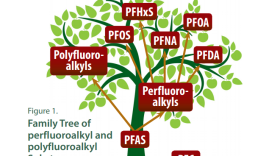In the 1970’s, the U.S. Air Force began using a firefighting foam that contained the chemicals PFOS and PFOA, which have contaminated water supplies in communities across the Northeast. The Air Force is now using a May 2016 lifetime health advisory level, or LHA, set by the EPA to determine safe levels and is cleaning up sites above acceptable levels. A recent update indicates there are still a few homes affected near the former Plattsburgh Air Force Base.
On February 15th the U.S. Air Force Civil Engineer Center updated the cleanup status of perflourinated compounds at its facilities.
The “Air Force PFOS/PFOA Snapshot” reports that 203 installations, including active, National Guard and closed bases, require preliminary assessments and of those 189 are expected to require a site inspection to identify current levels of contamination. Drinking water mitigation response is occurring at 21 installations. Options include bottled water, filtration, or hooking homes up to municipal water supplies. The latest update finds that four residential wells on Kemp Lane adjacent to the former Plattsburgh Air Force Base are above the LHA. Three homes are being fitted with water filtration systems and the fourth is receiving bottled water. It’s not new information, according to Town of Plattsburgh Supervisor Michael Cashman. “The Air Force, the federal government, has fully acknowledged that the contamination falls on their shoulders. The payment to build out the infrastructure and/or some other remedy again falls on their shoulders. We’re more than willing to help out. Right now the federal government is working with the homeowners to provide them you know bottled water etc. And this has been going on for some time. The news broke you know fairly recently but this has been going on for a while.”
Significant industrial development has occurred on the former military facility. Plattsburgh North Country Chamber of Commerce President Garry Douglas says water contamination has not impacted development at Plattsburgh International Airport. “Economic development new industrial development simply doesn’t use that ground source for water for any purposes and the Air Force has always been on the hook, will always be on the hook, for everything known and anything potentially unknown that turns up in the future.”
Douglas adds that following the closure of the base, concern centered on other environmental contaminants, and monitoring continues. “I know from my PARC (Plattsburgh Airbase Redevelopment Corporation) days you know a lot of the attention focused on the so-called plume on the flight side not on the side where these houses are. Caused as I recall in an unknowing way in the 1950’s and 1960’s that as part of firefighting training they would dump jet fuel on the ground set it afire and then put it out. But that plume has test monitoring wells on it that the Air Force will have to monitor in perpetuity. It’s way underground not actually impacting anything as long as it remains stable and development has continued on the surface above it. So even things that have been know have not actually stymied development at the airport.”
In Newburgh, a backup water source has been required due to PFOS contamination from the Stewart Air National Guard facility.Construction on a state-funded system was complete but not operating as of the February publication date. Unspecified non-drinking water mitigation was also listed at the Burlington Air National Guard facility in Vermont.










